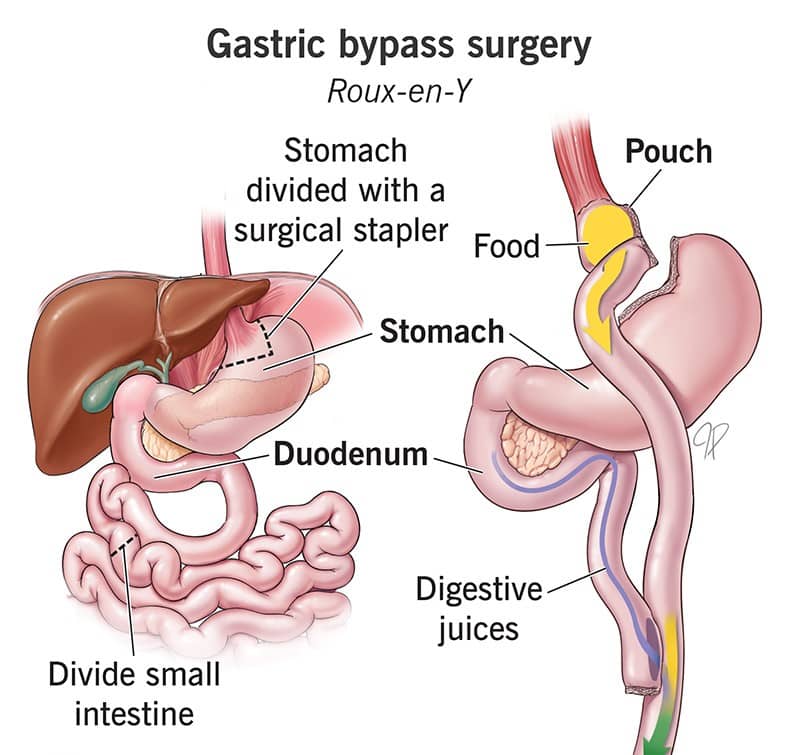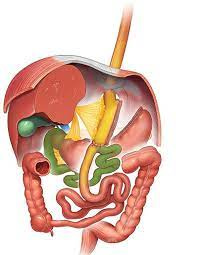Are you looking for information on Mini Bypass VS Full Gastric Bypass surgery?
First of all, we have to know that a Mini bypass is a misnomer as it’s also a complete bypass. In the old days when the gastric bypass was being done by open surgery, the Mini bypass was less complicated and relatively easy and could be done by minimally invasive surgery or laparoscopic surgery that is why it was called Mini bypass. It’s a strong procedure and in terms of weight loss or resolution of co-morbidities, it has the upper hand over traditional bypass. So its not at all mini as a bypass.
Both these surgeries have their own sets of benefits. However, only a bariatric specialist can best judge your eligibility and the success rate of that procedure.
Find out what our Bariatric Surgeon Dr. Manoj Khurana says about the traditional Gastric Bypass and the trendy Mini Gastric Bypass surgery.
Obese or overweight individuals are at risk of fatal cardiac events, and insulin resistance leading to diabetes, musculoskeletal disorders, and even some cancers. Weight loss surgery is a suitable option for extremely obese people with underlying medical chronic medical conditions such as diabetes and hypertension.
What is the difference between a Mini Gastric Bypass and a Gastric Bypass?
| Criteria | Mini-Gastric Bypass | Roux-en-Y Gastric Bypass |
|---|---|---|
| Operating time | Less | More |
| Simplicity | Simple | Complex |
| Safety | Same | same |
| Hospital stay | Equal | Equal |
| Cost | Equal | Equal |
| Food Tolerance | More | Less |
| Reversal | Easily possible | Possible but complicated |
| Weight loss percentage | Up to 70% (EBWL) | Up to 70% (EBWL) |
| Improvement in comorbidities | Significant | Significant |
| Complications | Less | More ( chronic pain, internal hernia ) |
| Recovery | same | same |
Why Gastric Bypass is known as the Gold Standard of Bariatric Surgery?
The gold standard is referred to as something that is considered to be the best, time-tested, and can be used to compare the quality of something similar.
“The American Society for Metabolic and Bariatric Surgery (ASMBS) and the National Institute of Health considers Roux-en-Y gastric bypass (RYGB) the “gold standard” of weight loss surgery.
When compared to other bariatric surgery procedures such as sleeve gastrectomy and laparoscopic gastric banding, gastric bypass is known to result in better weight loss results and improvement in metabolic functions.[6]
What Happens During Gastric Bypass?

RYGB
The procedure involves four major steps.
- A small pouch is created by dividing the top of the stomach from the rest of the stomach.
- The small intestine is divided into two parts – the smaller first part and the longer second part.
- The newly created small stomach pouch is connected to the upper end of the lower part of the intestine.
- The lower end of the upper intestine is connected to the small intestine further down. This is done to ensure that the digestive juices from the stomach and upper part of the intestine continue to mix with the food.
Mini Gastric Bypass Vs traditional Gastric Bypass (RNY): How Do They Work?
The mini-gastric bypass has a lot of differences compared to traditional gastric bypass surgery. However, both of these procedures work on three primary mechanisms:
1. Restriction
The size of the newly created pouch during both surgeries is significantly smaller than the original size of the stomach. Therefore, it facilitates smaller meal consumption and therefore, less calorie intake.
2. Malabsorption
There is less absorption of calories and nutrients. The food being eaten now bypasses the larger part of the stomach and upper part of the intestine. However, malabsorption can lead to malnutrition in case of gastric bypass. This is, however, avoided in mini gastric bypass surgery.
3. Changes in the Gut Microbiome
Gastric bypass induces changes in the gut microbiome. Malabsorption status after bariatric surgery and changes in the metabolism of bile acids, gastric pH, and metabolism of hormones lead to gut microbiota changes [4]
.
Since changes in microbiota also affect energy homeostasis, weight loss is achieved.
Mini Gastric Bypass VS Gastric Bypass: The Difference?
Traditional gastric bypass is very effective when it comes to weight loss. However, it is technically challenging and also carries a 7 per cent complication risk.[5]
In a bid to make the procedure simpler and reduce complications, Dr Robert Rutledge developed a mini gastric bypass in 1997. Also, known as one-anastomosis bypass, it is a less complicated version of traditional gastric bypass that may lead to similar weight loss.
Some of the key mini-gastric bypass vs traditional gastric bypass (RNY) differences are explained below.
Technique
Mini-gastric bypass involves less re-routing of the intestines. It involves the creation of a long narrow tube of the stomach along the right border with less curvature.

Next, a loop of the small intestine is brought up and hooked to this gastric tube. Because a mini-gastric bypass used low set loop reconstruction, there is only a rare chance of acid reflux.
On the other hand, a gastric pouch is created in the case of a traditional gastric bypass. The reconstruction of the gastrointestinal (GI) tract is then done to connect the small intestine to the lower end of the pouch.
Traditional gastric bypass, therefore, involves greater reconstruction of the GI tract and is more complicated.
Ideal Candidate for surgery
Candidates with gastroesophageal reflux disease (GERD) or bile reflux are NOT suitable candidates for a mini-gastric bypass. Such patients are recommended to undergo a traditional gastric bypass.
Operating Time
The operating time is significantly shorter for a mini-gastric bypass as compared to a traditional gastric bypass (115 versus 159 minutes) [6]
.
Simplicity and Safety
Mini-gastric bypass is considered safer than traditional gastric bypass. The former involves only one connection called anastomosis. On the other hand, the RNY gastric bypass involves multiple rerouting. This is one one the key mini-gastric bypass Vs traditional gastric bypass (RNY) differences.
Moreover, the mini-gastric bypass is a simpler technique for surgeons. It is an effective, relatively low-risk, and low-failure bariatric procedure
.
Efficacy (Percentage of Postoperative Weight Loss)
Excess weight loss is significantly greater in mini-gastric bypass candidates in the first year of follow-up. However, the difference is not significant at 2 years of follow-up
.
Both procedures are, therefore, effective treatments for morbid obesity.
Hospital Stay
The average hospital stay for both types of surgeries is the same, about two to 3 days. In the case of open gastric bypass, the duration of hospital stay can be up to 6 days.
Use of Medications
Gastric bypass patients typically required a higher dose of analgesics during the hospital stay. This is because, during traditional gastric bypass surgery, the small intestine is shortened. This leads to the loss of a great part of active drug carriers located in that area.
Therefore heavier doses are needed for effective results.
Improvement in Obesity-related Parameters
Both groups of patients experience a significant improvement in obesity-related comorbidities such as hypertension, diabetes, high uric acid, reduced liver function, and high lipid levels.
Recovery Time
Recovery is quicker for both groups of patients since the procedure is performed laparoscopically. However, since mini gastric bypass is a less complicated procedure, recovery is quicker for such patients and the downtime is less.
Postoperative Complication Rate
The rate of major complications in the case of a mini-gastric bypass is negligible. On the other hand, it is about 5 percent of patients undergo traditional gastric bypass.
The rate of minor complications in mini-gastric bypass is about 7.5 percent, as compared to 15 percent in the other patients.
The most common major complication in the case of gastric bypass is anastomotic leakage. Gastrointestinal bleeding and leakage from drainage tubes are minor complications. It can be observed in both the category of patients.
Possibility of Revision Surgery
Mini-gastric bypass, being less complicated, can be easily revised, converted, or reversed. However, that is not generally preferred in the case of gastric bypass as the procedure is complicated and risky.
Traditional gastric bypass reversal can be done on a carefully selected patient population if there are no alternative strategies available. [9]
Food Tolerance
Food tolerance is better in patients who undergo a mini-gastric bypass as compared to traditional gastric bypass.
Both approaches result in equal weight loss over a period of two years. However, due to less complexity and lower cost, the mini-gastric bypass is now emerging as the preferred choice of procedure.
Check these links to know the clinical outcome of both procedures: Gastric bypass and mini-gastric bypass success rates
The candidates should, however, discuss their eligibility with the specialists before making a decision. To observe significant weight loss, it is important in the case of both surgeries to follow the dietary guidelines and take supplements.